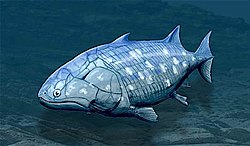Guiyu oneiros
|
Guiyu Temporal range: Late Silurian, 419 Ma |
|
|---|---|
 |
|
| Artist's concept of Guiyu oneiros. | |
| Scientific classification | |
| Kingdom: | Animalia |
| Phylum: | Chordata |
| Superclass: | Osteichthyes |
| Class: | Sarcopterygii |
| Genus: |
†Guiyu Zhu et al., 2009 |
| Type species | |
|
†Guiyu oneiros Zhu et al., 2009 |
|
Guiyu oneiros is the earliest articulated bony fish discovered. The generic name Guiyu is a transliteration of the Mandarin 鬼魚 guǐyú "ghost fish" and the specific name oneiros is from Greek ὄνειρος "dream". Fossils of Guiyu have been found in what is now Qujing, Yunnan, China, in a late Silurian marine strata, about 419 million years old. Guiyu remains have been found articulated, missing only the caudal fin. The living fish is estimated to have been 33 cm long.
Guiyu was described by Chinese palaeontologist Min Zhu and others in 2009, based on a near-complete articulated specimen. It was described as a basal lobe-finned fish with anatomical features of both ray-finned and lobe-finned fishes, although, analysis of the totality of its features place it closer to the class Sarcopterygii (lobe-finned fishes).Guiyu sheds light on the early diversification of bony fishes. This clade, the osteichthyans, splits in two clades: the lobe-finned and the ray-finned (Actinopterygii) fishes. According to new data from Guiyu, this split occurred no later than 419 million years ago, during the early Devonian period. Guiyu had spine-bearing pectoral girdle, a feature which can be found in primitive gnathostome vertebrates. Other early bony-fish with remarkable features include Andreolepis, Lophosteus, Psarolepis, Ligulalepis and Dialipina.
Guiyu is part of the Xiaoxiang fauna which is rich in fossils representing a marine ecosystem. Found in the late Ludlow-aged Kuanti Formation, the remains were dated using conodonts as index fossils. The Xiaoxiang fauna also includes galeaspids, placoderms and acanthodians.
...
Wikipedia
